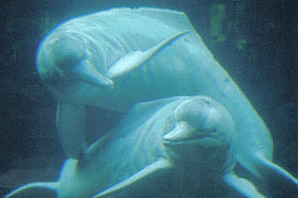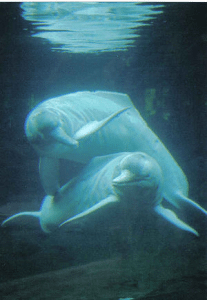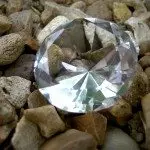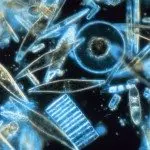Continued from Part 1
Let’s start with the Amazon/Pink River Dolphin’s first cousins, the Bolivian River Dolphin. They live in the same river system (in the Madeira, a tributary of the Amazon), but up a 225 mile (360km) stretch of 18 rapids. I couldn’t find the height of the falls/rapids they are talking about, but this blog post will give you an idea of how much of a drop there is in places.
How did they get there? National Geographic says that there was a drought about 100,000 years ago that stopped the Bolivian sub-group from mingling with the rest of the Amazon Dolphins. That would have been some “drought”!
We don’t have enough info to make such speculations, but we do know that these dolphins settled into their current location between the Flood’s peak and the end of the Ice Age -not 100,000 years ago. Having been separated all this time (around 4,000+ years), they are different enough from their downriver cousins to be classified as a separate “sub-species” now.
There are several other River/Brackish Water Dolphins along the South American coast. The La Plata or Franciscana Dolphin has members in the ocean, in the mouths of rivers around the Southeastern coast and up river far enough to be considered River Dolphins. They have dorsal fins like ocean dolphins, but long snouts and flexible necks like River Dolphins.
All River Dolphins are at risk of going extinct because their homes are limited to one area, so if something happens to their particular river, they’re stuck!
The Dolphins of South America are not being treated meanly on purpose (except for some stories of fishermen using their meat as bait), but accidents happen when people are around, and you saw in Part 1 how long it takes for a new generation of young dolphins to replace killed ones.
In South America there is bootleg gold mining going on which leaches mercury into the water to the fish. When the Dolphins eat these fish, they get high doses of mercury and can die out in that area. Of course, mercury in the water isn’t good for people either, so the governments of these places are working to stop this from happening.
The River Dolphins of South Asia aren’t doing so well, though. The Baiji (Buy-G) or Yangtze Dolphin hasn’t been seen for sure since before 2007. It looked a lot like the South American River Dolphins but was bluish-gray in color. Adults could be so pale that they were called the White Dolphin. Scientists figure that even if a few of these shy animals are still living, there aren’t enough to rebuild a healthy population again. Because of the thoughtlessness and poverty of people along the Yangtze river, we’ve lost another animal to the fossil record.
In Southwest Asia live the Indus River and Ganges River Dolphins. I don’t have room to write more about them, so be sure to follow the links to see where they live. They are also endangered with numbers of only a little over a thousand of each group.
These River Dolphins are known for being very slow swimmers with eyes that have no lenses so they’re almost blind. So, what they do is swim on their sides at the bottom of the river and open their mouthes when they feel and hear something to eat ahead. Like other River Dolphins they like fish, shrimp and other crunchy things that live along the river bottoms.
Besides these groups of properly titled River Dolphins, the Solari (aka Tucuxi, see Part 1) of the Amazon and the Irrawaddy dolphin of South Asia also live in rivers and their deltas. But these are both classified as part of the group of ocean living dolphins. In fact, both of these varieties have saltwater cousins. They have dorsal fins and don’t have extra long snouts like most River Dolphins.
Check out great pictures in National Geographic’s Photo Article about River Dolphins (and Porpoises)
Plus, the Whale and Dolphin Conservation Society has some good info.
So is this great and wide sea, wherein are things creeping innumerable, both small and great beasts…. These wait all upon thee; that thou mayest give them their meat in due season. That thou givest them they gather: thou openest thine hand, they are filled with good. Thou hidest thy face, they are troubled: thou takest away their breath, they die, and return to their dust. Thou sendest forth thy spirit, they are created: and thou renewest the face of the earth. Psalm 104:25-30
Then said he unto me, These waters issue out toward the east country, and go down into the desert, and go into the sea: which being brought forth into the sea, the waters shall be healed. And it shall come to pass, that every thing that liveth, which moveth, whithersoever the rivers shall come, shall live: and there shall be a very great multitude of fish, because these waters shall come thither: for they shall be healed; and every thing shall live whither the river cometh. Ezekiel 47:8,9








